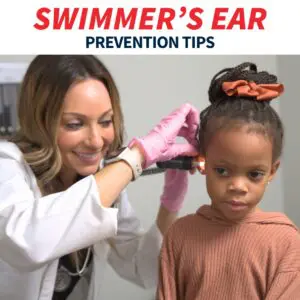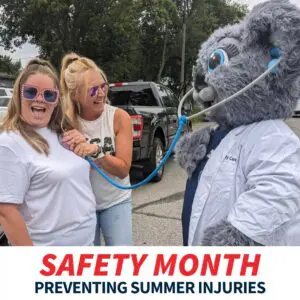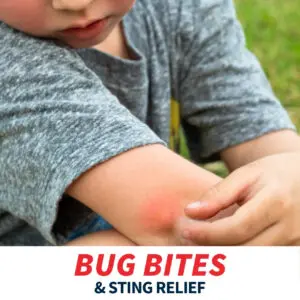How to Avoid Burn Injuries this 4th of July
With the Fourth of July just around the corner, many Americans are heading to their local fireworks store to stock up for the holiday. While enjoying a fireworks show with friends and family may be a staple of Independence Day celebrations, fireworks pose serious safety risks when not handled properly. According to the U.S. Consumer Product Safety Commission, there were 3,680 fireworks-related burn injuries in 2021 alone. Read on to learn more about the different types of burns, how they are treated and how you can stay safe while enjoying fireworks this Fourth of July.
Types of burns
A burn occurs when skin tissue is damaged by exposure to high heat, sunlight, electricity, radiation or chemicals such as cement, bleach or acids. There are three types of burns, classified by severity. Doctors and healthcare providers first identify the type of burn a patient is experiencing in order to determine the best treatment.
First degree burn: Also referred to as superficial burns, first-degree burns cause minimal skin damage, as they only affect the outermost layer of skin (epidermis). Signs of a first-degree burn include redness, pain, minor inflammation and dry, peeling skin that occurs as the burn heals. Patients can expect a first-degree burn to heal within seven to 10 days without any scarring.
Second-degree burn: These types of burns affect the skin’s outermost and lower layers (dermis). Second-degree burns typically cause the skin to blister and become very red and sore. In some cases, blisters will pop open, causing the burn area to appear somewhat wet. Over time, a thick, scab-like tissue (fibrinous exudate) may develop over the wound as it heals, which can take two to three weeks on average.
Third-degree burn: Third-degree burns are the most severe, as they affect every layer of the skin and cause significant tissue damage. Common signs of a third-degree burn include skin that is charred, has a raised and leathery texture, and exhibits a waxy, whitish-brown color. A patient with third-degree burns may not experience much pain due to extensive nerve damage. Third-degree burns require emergency medical attention and 911 should be called immediately in the event of a third-degree burn injury.
How to treat burns
Burn treatments range from home care remedies to surgery and physical therapy. Regardless of the type of burn, it’s strongly recommended to see a healthcare provider as soon as possible to accurately diagnose and treat the burn before it gets worse.
First-degree burn treatment: For minimal first-degree burns, a combination of home care remedies and OTC first aid products are recommended. Common treatment recommendations include soaking the wound in water for at least five minutes, applying antibiotic ointment and lidocaine with aloe vera gel to soothe the skin and prevent infection, using gauze to protect the burn area and taking OTC pain relievers such as ibuprofen or acetaminophen.
Second-degree burn treatment: Treating mild second-degree burns involves home remedies such as running cool water over the skin for 15 minutes or longer, applying antibiotic cream to heal blisters and taking OTC pain relievers. In more severe second-degree burns, skin grafting may be required to properly heal the affected area. It’s imperative to keep the burn area clean and bandaged at all times during the healing process to prevent infection.
Third-degree burn treatment: Third-degree burn patients most commonly require skin grafts. Untreated third-degree burns will result in extreme scarring, which is why it’s crucial to get medical attention immediately. Emergency healthcare providers will also administer fluids through an IV to keep the patient’s blood pressure steady and prevent dehydration or shock.
Fireworks safety tips
To ensure you and your family stay injury-free this Fourth of July, here are some helpful safety tips to keep in mind when handling fireworks:
- In case of fire, keep a bucket of water or a garden hose nearby when handling fireworks.
- Never allow young children to handle fireworks, even sparklers. Contrary to popular belief, sparklers pose a serious safety hazard. Sparklers burn at a temperature close to 2,000 degrees Fahrenheit, which can ignite clothing and cause burns if they come into contact with the skin. Older children holding sparklers should be closely monitored to prevent accidents.
- Create a safety perimeter for spectators. For ground-based fireworks, spectators should stand a minimum of 35 feet away.
- Light fireworks one at a time, as lighting multiple fireworks at once increases the risk of accidents.
- Soak all used fireworks in water for a few hours before throwing them away.
- Never attempt to relight malfunctioning fireworks. Instead, let them sit on the ground for five to 10 minutes before soaking them in water.
- Do not hold fireworks in your hand when lighting them. Make sure they are secured on the ground away from people and pets, and use a stem lighter to maintain distance when lighting the fuse.
If you or a loved one experience a first-degree burn injury, visit Midwest Express Clinic to receive treatment from our expert healthcare providers. To find a clinic nearest you, visit midwestexpressclinic.com/locations.




